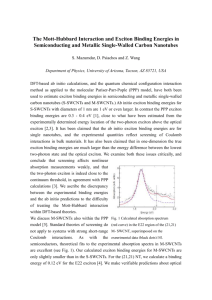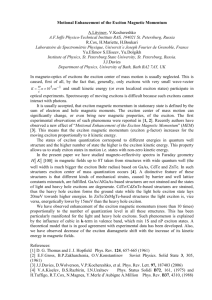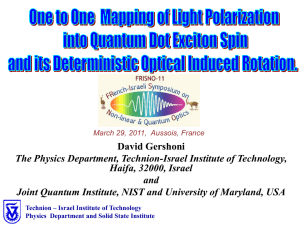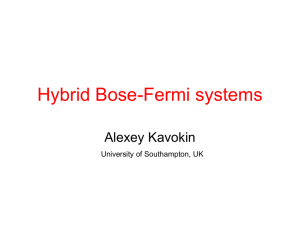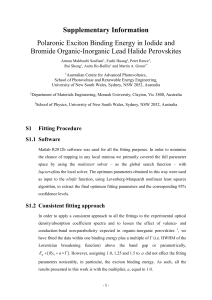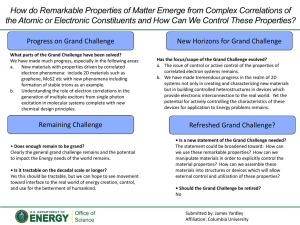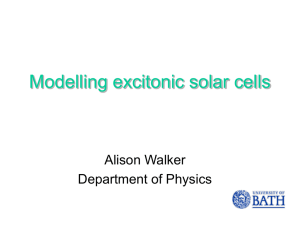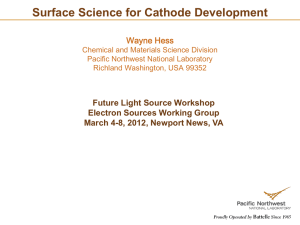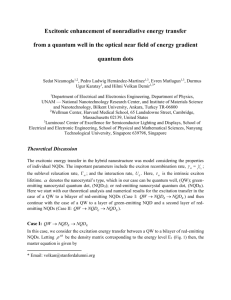Experimental setup
advertisement
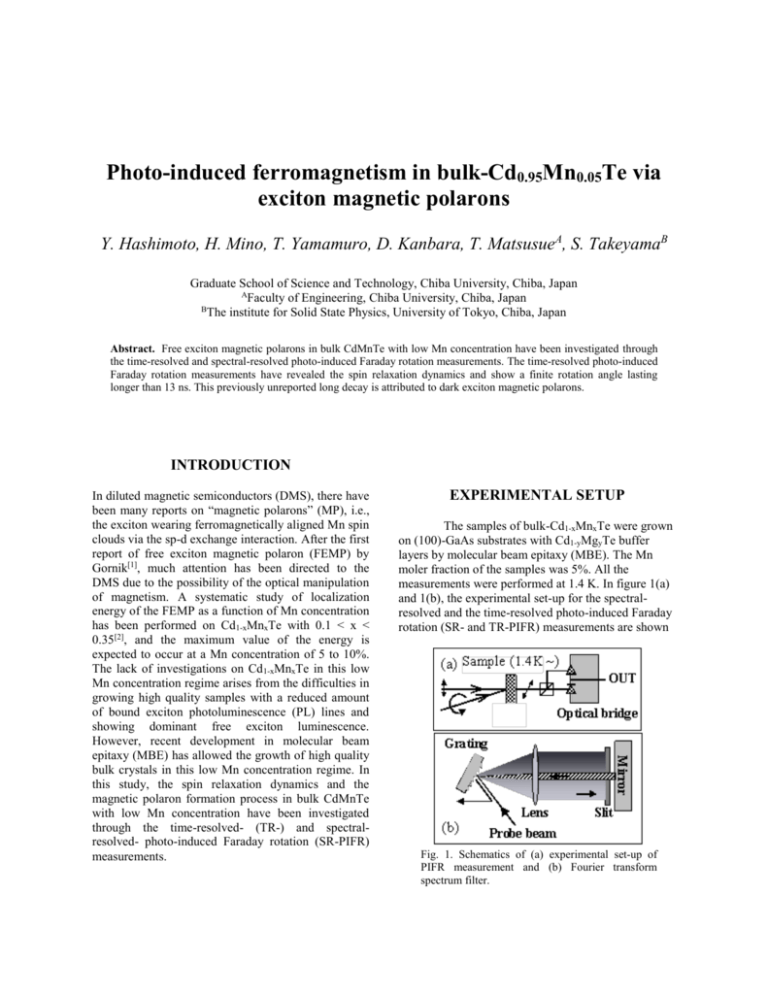
Photo-induced ferromagnetism in bulk-Cd0.95Mn0.05Te via exciton magnetic polarons Y. Hashimoto, H. Mino, T. Yamamuro, D. Kanbara, T. MatsusueA, S. TakeyamaB Graduate School of Science and Technology, Chiba University, Chiba, Japan A Faculty of Engineering, Chiba University, Chiba, Japan B The institute for Solid State Physics, University of Tokyo, Chiba, Japan Abstract. Free exciton magnetic polarons in bulk CdMnTe with low Mn concentration have been investigated through the time-resolved and spectral-resolved photo-induced Faraday rotation measurements. The time-resolved photo-induced Faraday rotation measurements have revealed the spin relaxation dynamics and show a finite rotation angle lasting longer than 13 ns. This previously unreported long decay is attributed to dark exciton magnetic polarons. INTRODUCTION In diluted magnetic semiconductors (DMS), there have been many reports on “magnetic polarons” (MP), i.e., the exciton wearing ferromagnetically aligned Mn spin clouds via the sp-d exchange interaction. After the first report of free exciton magnetic polaron (FEMP) by Gornik[1], much attention has been directed to the DMS due to the possibility of the optical manipulation of magnetism. A systematic study of localization energy of the FEMP as a function of Mn concentration has been performed on Cd1-xMnxTe with 0.1 < x < 0.35[2], and the maximum value of the energy is expected to occur at a Mn concentration of 5 to 10%. The lack of investigations on Cd1-xMnxTe in this low Mn concentration regime arises from the difficulties in growing high quality samples with a reduced amount of bound exciton photoluminescence (PL) lines and showing dominant free exciton luminescence. However, recent development in molecular beam epitaxy (MBE) has allowed the growth of high quality bulk crystals in this low Mn concentration regime. In this study, the spin relaxation dynamics and the magnetic polaron formation process in bulk CdMnTe with low Mn concentration have been investigated through the time-resolved- (TR-) and spectralresolved- photo-induced Faraday rotation (SR-PIFR) measurements. EXPERIMENTAL SETUP The samples of bulk-Cd1-xMnxTe were grown on (100)-GaAs substrates with Cd1-yMgyTe buffer layers by molecular beam epitaxy (MBE). The Mn moler fraction of the samples was 5%. All the measurements were performed at 1.4 K. In figure 1(a) and 1(b), the experimental set-up for the spectralresolved and the time-resolved photo-induced Faraday rotation (SR- and TR-PIFR) measurements are shown Fig. 1. Schematics of (a) experimental set-up of PIFR measurement and (b) Fourier transform spectrum filter. schematically. The excitation source was a modelocked Ti:sapphire laser producing 200 fs pulses with 80MHz. The pump pulse was circularly polarized and the probe pulse was linearly polarized. They were focused on the same position of the sample surface with a spot size of 200m in diameter. The excitation density was estimated to be 0.1J/cm2. In order to spectral-resolve the PIFR signal, a Fourier transfer spectrum filter (FTSF) shown in figure 1(b) was used. The FTSF narrowed the spectral half width of the probe pulse down to 0.7 nm and varies the energy of the probe pulse by varying the slit position. The rotation of the linearly polarized probe light was measured by means of an optical bridge with a precision better than a milli-degree (Fig. 1(a)). RESULTS AND DISCUSSIONS In figure 2(a), the temporal profiles of the PIFR at 1.4 K are shown. The solid and dotted curves were obtained by right-handed and left-handed circularly polarized pumping, respectively. The photon energy of the pump and probe pulse was set at the band edge exciton (EX) resonance. The rise time of the signal is limited by the laser pulse width, and the decay contains three contributions of very different relaxation time. The first decay time, less than 1 ps, is attributed to a hole spin relaxation. The second decay of 8 ps transient corresponds to an exciton spin PIFR [a. u.] PIFR amplitude 0 (a) SUMMARY 1.4 K 10 20 Time delay [ps] 30 Negative delay time (b) 0 relaxation. The third process has a long decay time and appears even in negative delay region. This indicates that the signal persisted more than 13 ns, which is the period of the mode-locked laser used for the pumping. We attribute this long decay to the dark exciton magnetic polarons (DEMP) that remain long time due to the prohibition of the radiative recombination. In the following, we will have brief discussion about the formation process of the DEMP. Assuming the righthanded circularly polarized excitation, the pump pulse excites bright exciton with +1 angular momentum. Individual spin relaxation of the hole and electron spins results in the formation of the light hole dark excitons with 0 angular momentum and the heavy hole exciton with –2 angular momentum. In the diluted magnetic semiconductor, the heavy hole dark exciton will form the DEMP via the p-d exchange interaction. The spin-polarized DEMP will act as a spin reservoir that feeds the bright exciton states via electron and hole spin flip. In order to clarify the nature of the long decay signal in PIFR, we spectrum resolve the PIFR signal at negative delay region. The spectral profile of the PIFR signal in the negative delay region is shown in figure 2(c). One can see that the PIFR spectrum shows the maximum value at the band edge exciton resonance. Theoretical analysis of the PIFR spectrum[3] indicates that the observed PIFR spectrum implies the energy splitting between the exciton states with +1 and –1 angular momentum. This means the ferromagnetically aligned Mn spins via the DEMP formation cause the Zeeman splitting of the bright exciton states. The ferromagnetic orientation of the Mn spins via the DEMP formation can be interpreted as the ferromagnetism mediated by the dark exciton. FX resonance Spin-dependent transient absorption and spectrum- and time-resolved photo-induced Faraday rotation measurements were performed. The temporal profile of the PIFR shows the long decay of longer than 13 ns. The PIFR spectrum at negative delay region shows the maximum value at the band edge exciton resonance and attributed to the Zeeman splitting caused by the ferromagnetically aligned Mn spins via the magnetic polaron. 1.670 1.675 Photon Energy [eV] Fig. 2 (a) Photo-induced Faraday rotation for rightand left- cirularly polarized pump as a function of the delay time between pump and probe pulse. (b) Photo-induced Faraday rotation spectrum at negative delay region REFERENCES 1 A. Golnik et al., J. Phys. C16, 6073 (1983) 2 S. Takeyama, J. Cryst. Growth 184/185, 917 (1988) 3 W. Maslana et al., Phys. Rev. B 63, 165318 (2001)
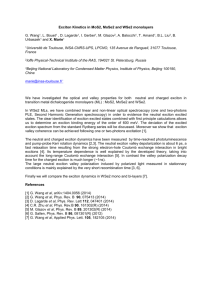
![Supporting document [rv]](http://s3.studylib.net/store/data/006675613_1-9273f83dbd7e779e219b2ea614818eec-300x300.png)
